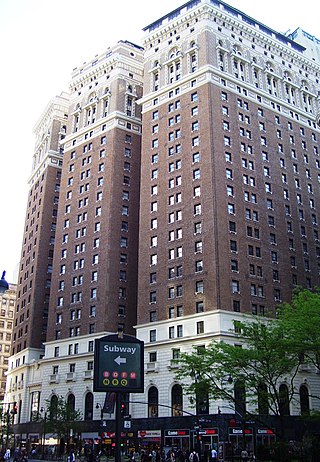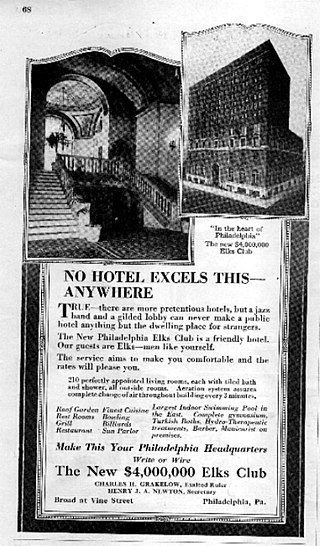Kirtland Kelsey Cutter was a 20th-century architect in the Pacific Northwest and California. He was born in East Rockport, Ohio, the great-grandson of Jared Potter Kirtland. He studied painting and illustration at the Art Students League of New York. At the age of 26 he moved to Spokane, Washington, and began working as a banker for his uncle. By the 1920s, Cutter had designed several hundred buildings that established Spokane as a place rivaling Seattle and Portland, Oregon in its architectural quality. Most of Cutter's work is listed in State and National Registers of Historic Places.

The Benevolent and Protective Order of Elks is an American fraternal order founded in 1868, originally as a social club in New York City.

The Hamilton Building also known as The Flatiron Building of Bellingham and the Bellingham Bay Furniture Building was the first "skyscraper" in Bellingham. Built in 1908 for Talifero Simpson Hamilton's growing Bellingham Bay (B.B.) Furniture Company established in 1889, the building cost $100,000 and used thirty-five thousand barrels of cement along with 200,000 pounds of steel. Due to its triangular shape and resemblance to the Fuller Building in New York, the building instantly garnered the flatiron nickname. It was Bellingham's tallest structure until 1926.

The Bellingham National Bank Building is an historic commercial/office building located in downtown Bellingham, Washington. It was originally built from 1912 to 1913 in a restrained Beaux Arts commercial style with reinforced concrete. Even though this particular style was common for cities in the midwest and east coast, the building style was a stark contrast for Bellingham's sandstone and rounded arch buildings. The Bellingham National Bank occupied the building starting on December 1, 1913.

Herald Towers, formerly the Hotel McAlpin, is a residential condominium building on Herald Square, along Broadway between 33rd and 34th Streets, in the Midtown Manhattan neighborhood of New York City. Constructed from 1910 to 1912 by the Greeley Square Hotel Company, it operated as a short-term hotel until 1976. The building was designed by Frank Mills Andrews in the Italian Renaissance style and was the largest hotel in the world at the time of its completion, with 1,500 guestrooms. The hotel was expanded in 1917, when Warren and Wetmore designed an annex with 200 rooms.

The James B. Duke House is a mansion at 1 East 78th Street, on the northeast corner of Fifth Avenue, on the Upper East Side of Manhattan in New York City. The building was designed by Horace Trumbauer, who drew heavily upon the design of Château Labottière in Bordeaux. Constructed between 1909 and 1912 as a private residence for businessman James Buchanan Duke and his family, the building has housed the New York University (NYU)'s Institute of Fine Arts since 1959.

The Benevolent and Protective Order of Elks Lodge, also known as the Elks Civic Building, is a historic building in Montrose, Colorado, United States. It served as an Elks lodge from construction in 1927 until 1969, and has since housed a college and city offices. In 2017 it was, and in 2019 still is, the location of the city's Visitors' Center. The building is listed on the Colorado State Register of Historic Properties and the National Register of Historic Places.

The Elks Lodge Building in Flint, Michigan, also known as Old Elks Building, was built in 1913. It was listed on the National Register of Historic Places in 1978.

The Elks Club Building is the second and former clubhouse of the Manila Elks Lodge #761—Manila Lodge 761, better known as the Manila Elks Club, in Manila, the Philippines. It was designed by William E. Parsons.

The Philadelphia Lodge No. 2 BPOE, also known as the Philadelphia Athletic Club, was an historic, American Benevolent and Protective Order of Elks (BPOE) lodge that occupied 306-320 North Broad Street in the Logan Square neighborhood of Center City Philadelphia.
The Improved Benevolent Protective Order of Elks of the World (IBPOEW) is an African-American fraternal order modeled on the Benevolent and Protective Order of Elks. It was established in 1897 in the United States. In the early 21st century, it has 500,000 members and 1500 lodges in the world.

The Briarcliff Lodge was a luxury resort in the village of Briarcliff Manor, New York. It was a notable example of Tudor Revival architecture, and was one of the largest wooden structures in the United States. It was also the first hotel in Westchester County. Walter William Law had it built on his estate, and the Law family owned it until 1937. When the lodge opened in 1902, it was one of the largest resort hotels in the world. The lodge hosted presidents, royalty, and celebrities, and was the scene of numerous memorable occasions for visitors and local residents who attended weddings, receptions, and dances in the ballroom and dining room. For a long time, the lodge was situated among other businesses of Walter Law, including the Briarcliff Farms and Briarcliff Table Water Company.

The Columbia Hotel is a former European-style hotel in Ashland, Oregon, and at the time of its closing in 2021 had been in continuous operation since its construction in 1910. The hotel occupied the second floor of the Enders Building, listed on the National Register of Historic Places in 1986.

Benevolent and Protective Order of Elks, Lodge Number 878 is a historic Elks lodge on Queens Boulevard in the Elmhurst neighborhood of Queens in New York City. The 3+1⁄2-story Italian Renaissance-style main building and two-story annex were both built in 1923–1924 and designed by the Ballinger Company. A three-story rear addition was added in 1930.

The Grover Museum, formally known as the Louis H. and Lena Firn Grover Museum, is a local history museum located in Shelbyville, Indiana, USA, and is operated by the Shelby County Historical Society, whose headquarters are located in the building. The museum has three rotating galleries and three permanent galleries, which are used to display artifacts that are historically significant to Shelby County, Indiana.

The Barnes Building, originally known as the Odd Fellows' Block, the Masonic Temple from 1909 to 1915, and later Ingram Hall, is a historic fraternal and office building located at 2320-2322 1st Avenue in the Belltown neighborhood of Seattle, Washington. Designed in early 1889 and constructed in late 1890 by Seattle Lodge No. 7 of the International Order of Odd Fellows and designed for use by all of the city's Odd Fellow lodges, it is the earliest known surviving work of Seattle architect William E. Boone and George Meeker and remains in an almost perfect state of preservation. The Barnes building has played an important role in the Belltown Community and Seattle's dance community. It was used by the Odd Fellows for 17 years before their departure to a newer, bigger hall in 1909 and was home to a variety of fraternal & secret societies throughout the early 20th century, with the Free and Accepted Masons being the primary tenant until their own Hall was built in 1915. The ground floor has been a host to a variety of tenants since 1890 ranging from furniture sales to dry goods to farm implement sales and sleeping bag manufacturing, most recently being home to several bars. It was added to the National Register of Historic Places as The Barnes Building on February 24, 1975.

John Joseph Donovan was a Washington State pioneer and the president of the state Chamber of Commerce, as well as one of the key founders of the City Council of Bellingham, Washington. During his life, Donovan actively participated in political, industrial, and commercial activity on city, county, and state levels. Several historic landmarks exist in Bellingham honoring J. J. Donovan, including his house, which was added to the National Historic Register, and a bronze statue installed in Fairhaven, Washington.

4 Park Avenue is a 22-story building in the Murray Hill neighborhood of Manhattan in New York City. Designed by Warren and Wetmore, the structure was built for Alfred Gwynne Vanderbilt and opened in 1912 as a hotel. It is along the west side of Park Avenue between 33rd and 34th Streets. Following a renovation by Schuman, Lichtenstein & Claman between 1965 and 1967, the top 18 stories have been used as residential apartments. The lowest three stories above ground, as well as three basement levels, are used as commercial space and carry an alternate address of 6 Park Avenue. As of 2021, the building is owned by The Feil Organization.

The Downtown Paris Historic District, in Paris, Kentucky, in Bourbon County, Kentucky, is a historic district which was listed on the National Register of Historic Places in 1989.




















